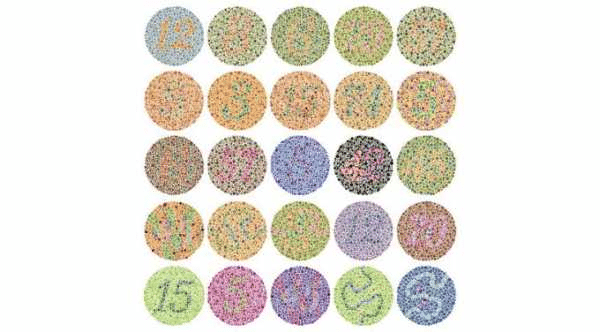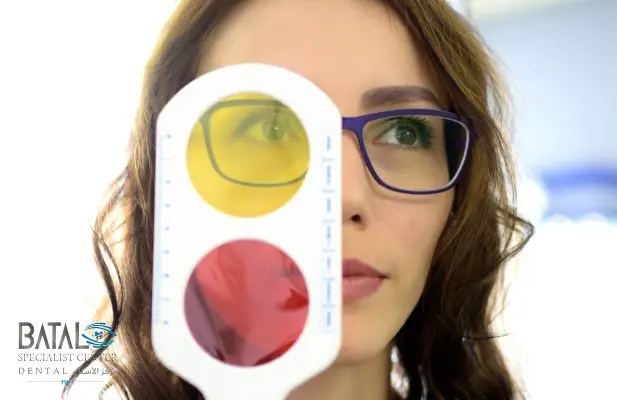Med info
Color blindness screening – types, tests at Batal Specialized Complex

What is color blindness and how does it affect your vision?
Color blindness or “lack of color vision” is defined as a condition that affects a person’s ability to distinguish between certain colors, especially red and green or blue and yellow. In mild cases, the affected person may not realize the problem, while in severe cases, it is difficult to distinguish between colors that others see clearly.
Studies show that color blindness affects about 1 in 12 men and 1 in 200 women, making it more common than we think.
Do you suspect that you have difficulty distinguishing colors? Continue reading the article to discover the types of color blindness, examination methods, and the most important tests available, or book your appointment now at Batal Specialized Complex in Jeddah to conduct a comprehensive evaluation of vision functions.

What is the difference between a color blindness test and a visual acuity test?
Both color blindness screening and visual acuity screening are an essential part of a comprehensive visual assessment, as each helps diagnose different conditions that affect vision.
Color blindness examination
Color blindness –also known as color vision deficiency– is a condition that affects a person’s ability to distinguish certain colors, and it is often difficult to differentiate between shades of red and green or blue and yellow.
The Ishihara test is used as an essential tool in diagnosing this condition, as the patient is asked to recognize numbers or shapes hidden within certain color patterns.
Visual strength test
Vision strength reflects how sharp and clear vision is, and is used to determine whether a person has myopia, farsightedness, or astigmatism (astigmatism).
This test is usually performed using:
- Snellen chart for reading characters of different sizes.
- Refraction test to determine the type of appropriate corrective lenses.
- To learn more about other vision tests, you can try a vision test at home

The most important tests for diagnosing color blindness
Below is a brief description of the color blindness test:
Ishihara Test (Ishihara Test) – Most widely used worldwide
Ishihara test This is the test that ophthalmologists most often use when adults come for appointments. The doctor shows you a series of dotted paintings of different colors and sizes. There are numbers or patterns hidden within the dots that individuals with normal color vision can see, but those with color vision deficiencies may have difficulty perceiving them. By correctly identifying numbers or patterns, the test can determine the presence and type of color vision deficiency.
Donders Test
The Donders test, also known as the pseudoplate test, is another type of color blindness screening test. It uses panels with colored dots arranged in specific patterns. Individuals with normal color vision can distinguish embedded shapes or numbers from the background, while those with color vision deficiencies may have difficulty doing so.
Anomaloscope test
Anomaloscope is a tool that tests the shortcomings of red and green. It is a simple color matching test that uses two different light sources – red and green light sources that must match the yellow light source.
The examiner looks through the lens and sees a circle – the lower half is a mixture of green and red lights, and the upper half is a yellow light. The examiner is asked to match the brightness and colors of the lights. Using an anomalous endoscope, in this test it is possible to detect different types of red-green color defects.
Hardy-Rand-Rittler Test
More commonly known as Richmond HRR, this test checks for decreased vision of red, green, blue, and yellow. It also indicates whether your condition is mild, moderate, or severe. You look at 24 panels, each containing one or two symbols (including circles and triangles). You can specify what you see and where it is on the board.

The importance of color blindness screening
Color blindness tests are important for several reasons:
- Early detection: Screening for color blindness can help identify color vision deficiencies at an early stage, allowing for timely intervention and management. Early detection is especially crucial in situations where color perception is essential, such as certain professions (such as pilots, electricians, graphic designers) or when it may affect daily activities.
- Professional Considerations: Some professions require careful color perception, as it is an integral part of performing job tasks safely and effectively. A color blindness test helps evaluate an individual’s ability to perceive and distinguish between colors
- Safety Measures: Color vision plays a crucial role in various safety-related situations, such as interpreting traffic signs, identifying warning signs, or distinguishing color-coded information.
- Personal Awareness: Screening for color blindness can provide individuals with a better understanding of their visual perception. It helps them recognize any limitations or differences they may have compared to other individuals. This awareness can be helpful when engaging in activities that rely heavily on color discrimination.
- Psychological impact: The discovery of color vision deficits can have psychological and emotional effects on individuals. It may help explain previous challenges they faced, such as the difficulty of color-related tasks, and provide reassurance that their vision is working normally in other aspects.
Some other vision problems, such as blurred vision, may require similar comprehensive examinations.
Tips for undergoing a color blindness test
When getting tested for color blindness, here are some tips to keep in mind:
Consult an ophthalmologist at Batal Complex
It is best to consult an ophthalmologist at Batal Complex to conduct a proper color blindness test. They can conduct the test accurately and provide expert guidance based on the results.
Get enough sleep
Adequate rest is important for optimal visual function. Make sure you get a good rest before having a color blindness test to make sure your vision is not compromised by fatigue.
Avoid eye strain
Eye strain can affect the accuracy of test results. Take breaks from long screen time or intense visual activities before taking the test. Resting your eyes and avoiding stress will help you perform better during the test.
Use appropriate lighting
Proper lighting conditions are essential for accurate color perception. Avoid testing in dimly lit or very bright environments, as this can affect your ability to distinguish colors accurately. Choose a well-lit room with natural light.
Take your time
Color blindness tests often involve identifying patterns, numbers, or shapes included in color combinations. Take your time to carefully observe and analyze each image or pattern before providing your answer. Rushing to take the test may lead to incorrect results.

Color blindness examination at the Eye Center at Batal Specialized Complex in Jeddah
When conducting a color blindness test at the Eye Center at Batal Specialized Complex in Jeddah, here are some basic considerations:
- Make an appointment: Contact an eye center and schedule a dedicated color blindness test appointment. This will ensure that the necessary time and resources are allocated for testing.
- Inform employees: When making an appointment, inform employees that you would like to have a color blindness test, as this will help them prepare appropriate test materials and ensure they have the necessary experience to administer the test.
- Follow any preparatory instructions: The Eye Center at Batal Specialized Complex in Jeddah may provide specific instructions for preparation prior to the test. This can include avoiding certain medications or substances that may affect color perception. Be sure to follow these instructions to ensure accurate test results.
- Collaboration during testing: Color blindness screening may involve displaying specific images, patterns, or color palettes and identifying specific elements within them. Follow the instructions provided by your ophthalmologist and cooperate effectively during the test. Take your time to monitor and respond to each item carefully.
- Ask for clarification if necessary: If you are unsure about any aspect of the test or instructions, please feel free to ask for clarification. It is important to have a clear understanding of what to expect during testing to ensure accurate results.
- Discussing the results: After completing the test, the ophthalmologist at the Eye Center at Batal Specialized Complex in Jeddah will discuss the results with you. They will explain the results, any color vision deficiencies identified, and their effects. Take this opportunity to ask questions and get more information as needed.



